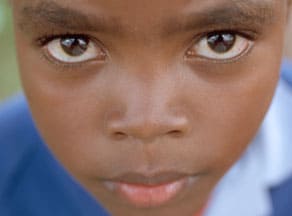While the East African nation of Kenya does not grab as many headlines as its less stable neighbors to the west, disease, malnourishment and violence are leaving a mark on this generation of Kenyan children.
 About 500,000 Kenyan children are missing school due to lack of food.
About 500,000 Kenyan children are missing school due to lack of food.
According to the World Food Program, in countries where school attendance is low, the promise of at least one nutritious meal each day boosts enrollment and promotes regular attendance. Where that is not offered, hunger interferes with the children’s concentration in class, affecting class performance. As famine takes its toll across the country, a growing number of students are staying away from school altogether to help their parents look for food (The Standard, Sept. 23, 2009).
Drought and famine have led to an increase in the high school dropout rate primarily in schools in the Njoro and Nakuru areas. While 29 percent of children in Nairobi are malnourished, that number increases to 42 percent in the Eastern Province (Daily Nation, Oct. 7, 2009).
The United Nations Scientific and Cultural Organization (UNESCO) has stated that malnutrition is the major barrier to universal primary education in Kenya.
Famine conditions have also affected livestock in the rural areas of Kenya, undermining the primary source of income for pastoralists, especially the Maasai population.
Malaria continues to be another source of concern, and an increase in cases is predicted because of the El Niño rains expected to pound the country. Malaria is the leading cause of death in Kenya, affecting mostly the rural poor, particularly young children and pregnant women. Most cases affect children under the age of 5 (Daily Nation, Oct. 7, 2009).
While mosquito nets have made a difference in squelching the malaria epidemic, researchers are discovering that mosquitoes are now feeding earlier in the evening, which reduces the effectiveness of the nets. While there has been a dramatic reduction of malaria in children under 5 years, the disease appears to be shifting to older children (Daily Nation, Oct. 30, 2009).
Other threats to Kenya’s children include the H1N1 virus, child abuse and abduction, and neglect. The number of orphans in Kenya has risen to more than 2.4 million. In 2008, 38,325 children were described as neglected and 2,753 were abandoned by their parents (The Standard, Sept. 29, 2009).
The effects of poverty are felt most severely in the country’s rural areas, where half of the population lives on less that Kshs. 1,560, versus the more urban areas where people earn an average of Kshs. 3,000 per month. Of the 40 million people living in Kenya, 16.6 million survive on one meal a day and are most likely to die of disease, hunger or political violence (The Standard, Oct. 29, 2009).







2 Comments |Add a comment
Yes, I’m also glad to know what to pray for our sponsored children there, and for those who are running the Compassion projects! Haiti has so dominated our prayers and thoughts, that it’s easy to forget the suffering and need in other areas. Thanks for this article!
Man, I take my life for granted!
I recently started sponsoring Bidan from Kenya, so I’m glad to know what to pray for now.